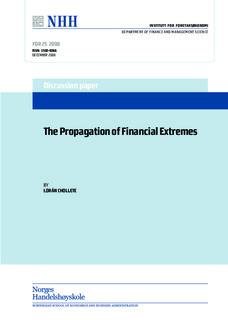| dc.contributor.author | Chollete, Lorán | |
| dc.date.accessioned | 2009-04-29T12:23:38Z | |
| dc.date.available | 2009-04-29T12:23:38Z | |
| dc.date.issued | 2008-07 | |
| dc.identifier.issn | 1500-4066 | |
| dc.identifier.uri | http://hdl.handle.net/11250/163963 | |
| dc.description.abstract | What drives extreme economic events? Motivated by recent theory, and events in
US subprime markets, we begin to open the black box of extremes. Specifically, we
extend standard economic analysis of extreme risk, allowing for dynamics and endogeneity.
We explain how endogenous extremes may arise in an economy of individuals
who engage in resource transfers. Our model suggests that susceptibility to extremes
depends on differences in marginal substitution rates. Using over a century of daily
stock price data, we construct empirical probabilities of extremes, and document interesting
dynamic behavior. We find evidence that extremes are endogenous. This latter
finding raises the possibility that control of extremes is a public good, and that extreme
events may be an important market failure for regulators and central banks to correct. | en |
| dc.language.iso | eng | en |
| dc.publisher | Norwegian School of Economics and Business Administration. Department of Finance and Management Science | en |
| dc.relation.ispartofseries | Discussion paper | en |
| dc.relation.ispartofseries | 2008:25 | en |
| dc.subject | extreme event | en |
| dc.subject | subprime market | en |
| dc.subject | dynamics | en |
| dc.subject | endogeneity | en |
| dc.subject | public good | en |
| dc.subject | central bank policy | en |
| dc.title | The propagation of financial extremes | en |
| dc.type | Working paper | en |
| dc.subject.nsi | VDP::Samfunnsvitenskap: 200::Økonomi: 210::Samfunnsøkonomi: 212 | en |
